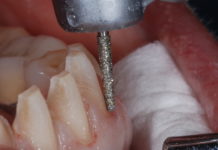
“DOWN” WITH DENTAL DISCOURAGEMENTS: SUCCESSFUL WAYS TO OVERCOME THEM.
Often when I conduct my courses, I am greeted by dentists who share with me some of their professional difficulties. Some struggle with financial issues. Others struggle with time management or staffing disputes. Still others struggle with not having a clearly-defined set of goals. Each time dentists share these types of experiences with me, my response is usually the same: “I’ve worn that T-shirt.” In other words, I know what it feels like to lack a sense of direction, to fear confrontation, to want to avoid financial organization, to seek the approval of others in an unhealthy way, and to feel uncertain about my technical skills. However, as I have sought ways to improve professionally and personally over the years, I have also discovered what it feels like to throw out those tattered tees emblazoned with negative messages and replace them with brand new ones proclaiming positive affirmations.
“Directionless” T-shirt vs. “Purpose-Driven” T-shirt
When I started my practice, I was fortunate to assume an existing practice with a wonderful production level. However, as the new CEO, CFO, and COO, I found myself losing control of the lumbering ship and the staff aboard it. The main reason for my difficulties at that time was a lack of vision. Sure, I had a general idea of the direction I wanted our ship to travel; however, I hadn’t solidified those ideas into a clear plan and because of that, both my crew and I felt like we were just aimlessly bobbing about on a sea of disarray.
It was at that time that I realized the utmost importance of establishing a mission statement. Yes, I had heard about this concept many times in the past. I had read about mission statements and I knew that business professionals highly recommended them. However, it wasn’t until I was trying to operate my own business that I realized the absolute necessity of having one. My mission statement allowed me to move from wearing a “directionless T-shirt” to a “purpose-driven T-shirt.”
Developing a mission statement isn’t something you can just quickly throw together during a morning office huddle. It takes time and serious effort. I recommend setting aside some time just for you—as the dentist and captain of the ship—to reflect on where you want the business to go and what you want to accomplish along the way. I personally took three days off and went camping and developed my ideas in a quiet, peaceful environment. Regardless of how and when you develop your statement, you should plan on at least spending a full day or even longer coming up with your initial ideas. Then, bring these ideas back to your staff and get their input. You need to have everyone on board and excited about the direction you want to travel in order to be able to do so successfully.
Once you’ve solidified all of your ideas, it’s time to write them. I suggest using “technicolor” words that radiate dynamic images and inspire actions. Maybe you don’t have the time nor creative flair to put pen to paper in such a manner. Not to worry. Hire a writer or marketing guru to do it for you on a contractual basis. Or if one of your office staff has a flair for the written word, utilize this person’s expertise.
I personally have my office’s mission statement attractively framed and displayed in a central location where both my staff and patients can read it. This allows the statement to be the focal point of the business and reminds everyone what we’re trying to accomplish. I also have the condensed version of my mission statement printed on the back of my business cards.
Remember, however, that the best mission statement in the world is totally useless if no one abides by it. Hold everyone in the office accountable to it, including (and most importantly) yourself. The mission statement is the affirmation of what the dentist is going to be and the type of leader he or she will be to the staff. The dentist really needs to be the role model, the captain of the ship as it were.
“Confrontation” T-shirt vs. “Care-frontation” T-shirt
Out of all of the T-shirts I have worn in my practice, the confrontation one was the most uncomfortable for me. It was my Achilles heel, you might say, if a T-shirt can be such a thing. Confrontation always created a visceral physiological reaction in my body: my heartbeat sped up, I found my breath becoming quick and shallow, I felt almost immobilized. If I needed to confront an employee, for example, it would take me days of rehearsal and sleepless nights to finally do it. Thus, the default mechanism I instinctively used to deal with such situations was avoidance. If I needed to confront someone on any type of issue, I would just put it off. The problem with that, though, is that the issue didn’t go away. In fact, it most often became worse and sometimes even grew into a monster that was much larger than the original problem. Because of that, I knew I needed to change this part of my personality or my business was going to suffer greatly because of it.
This is when I decided to remove my “confrontation T-shirt” and I replaced it with what I like to call my “care-frontation” T-shirt. The word “confront” evokes negative imagery in my opinion: there is a problem and someone has done something wrong. Generally, that someone ends up feeling badly about themselves by the end of the conversation since the focus was switched from the “problem” to the “relationship.” On the other hand, “care-frontation” evokes a very positive set of feelings. There is still a problem that needs to be discussed, but it is approached in such a way that both people leave the conversation feeling uplifted and hopeful.
I have found that the best way for me to handle issues in a “care-fronting” manner is to first have a clear set of expectations for your staff (i.e., mission statement). Then, if a problem needs to be handled, I recommend dealing with it right away in a kind and considerate manner. Say for example, I have a staff member who keeps coming in late and misses the morning huddle. The way I would approach this situation is with this dialogue:
“Susie, I have noticed that over the last few weeks you’ve been having difficulties getting here on time. As a team, we need each of our members here for the morning huddle so that we can all be on the same page throughout the day. What is it that I can do to help you be here on time?”
Speaking this way to “Susie” helps her know that she is an integral part of the team and her presence is valued. It also shows that you care about her situation. However, one important aspect of this dialogue is making sure that “Susie” knows that the responsibility of solving the problem ultimately lies with her. You can be a guide and a support, of course, but in the end she’ll need to do her part to fulfill her responsibilities on the job.
Showing this type of care for your employees will help make it easier for you to approach them with problems that arise and therefore keep the office running smoothly for everyone.
“Dreading-the-Numbers” T-shirt vs. “Financially-Competent” T-shirt
In my seminars, when I ask dentists what it costs them per hour to open up their practices, a disturbing 7 out of 10 dentists have absolutely no idea. These dentists are being shackled with what I’d like to call the “dreading-the-numbers” T-shirt. Believe me, I know how encumbering it can feel to be burdened with the financial part of a business. We became dentists to work on patients’ teeth, not crunch numbers in the office. But whether you want to take on the role or not, you really are the CFO of your practice. The best way to change into your “financially-competent” T-shirt is to get the skills you need.
To do that, I recommend gaining a better understanding of accounting principles by either taking some continuing-education courses, reading financial-help books, or by seeking out a mentor. I have personally done all three, and continue to do so in my practice today.
Another tip to financial competency is getting your “house” in order. You do that by living by the old adage, “Save for a rainy day.” Make sure you have a reserve for the lean times. I suggest having one and a half months in savings so that you can still meet payroll and pay the rent of the office space even if something happens in the economy, in the office, or in your personal life. You never know when some of your equipment might break and need to be replaced or when you have to close the office for a few days because of bad weather. I also strongly suggest living within your means, not only on a professional level but on a personal one as well. If you do so, you will be able to maintain that reserve and will therefore be freed from unnecessary financial stress. You don’t ever want to be placed into a position of desperation where you make decisions in your practice solely on the need to make ends meet. This type of mindset isn’t good for your practice, for your staff, and certainly not for your patients.
“Approval Addict” T-shirt vs. “I’m Okay” T-shirt
In the early years of my practice, it was very evident that I let my addiction for approval run my life and my business. Oftentimes, patients wouldn’t accept a treatment that I suggested, or they would want a discount, or they would tell me I was too expensive. I found myself giving away procedures for free or reducing a crown to a four-surface pin-amalgam just so my patients would like me.
Now, there’s nothing wrong with wanting to be liked and wanting your patients to be happy with you. But there needs to be a balance. If I’m making all of my choices solely on the fear that someone will not like me, then my business is definitely going to suffer. You have to be able to turn off that trigger in your head that says, “Oh, this patient won’t possibly want to pay for this treatment, so I need to just offer something else” and replace it with a positive affirmation that proudly proclaims, “Yes, this patient would benefit greatly by this treatment and it’s my job to help them figure out a way to make it happen.”
Removing my “approval addict T-shirt” and replacing it with that cool new “I’m okay” shirt is an ongoing daily process for me. I do it by removing the limiting beliefs in my own mind and not allowing them to squelch my natural, vibrant, authentic self. When I hear these limiting beliefs, I simply say to them: “Thank you for sharing, but I’m going to proceed forward in another direction instead.” As I have been able to incorporate this thought process into my life, I have been able to more clearly listen with my heart and march to a set of values that makes me feel whole and happy. This has helped my attitude, my productivity, and my overall practice.
This change in mindset can be compared to walking across hot coals. If, while doing such a task, people can keep their mind on the words “cool moss” as they walk across the sizzling embers, then they can make it across. If, however, their minds slip up for one second and they instead think the words, “hot coals,” then they won’t be able to do it. Their feet will instantly start to burn.
This metaphor can definitely be compared to the positive and negative affirmations in your own mind in relation to human interactions. If you always tell yourself, “Yes, what I am doing here is of value,” instead of “I’m not sure this person will like what I have done,” then, your ability to stay on the track towards success will be ever more possible.
“I Don’t Know What I Don’t Know” T-shirt vs. “I Have Technical Skills” T-shirt
The one thing I clearly remember when I reached the pinnacle of graduation and received my title of Doctor of Dentistry was the feeling of “I made it!” At that point, every technical skill I had acquired during the educational process was what I “knew.” What I didn’t realize at the time was how much I didn’t “know” and still needed to learn. The real world was quick to reveal that to me, though, and like every dentist, I even had to eat some humble pie on occasion as I worked through certain procedures. What’s important to remember is that it doesn’t matter if you are brand new to the industry or have been practicing dentistry for 30 years, at some point every day, we are all wearing the “I don’t know what I don’t know” T-shirt. However, it is possible that as we gain more knowledge in an area and more skills in a particular procedure, we are able to replace that tee with the “I have technical skills” T-shirt. But, how exactly does one do that?
The most obvious way is by taking continuing education classes, particularly those that incorporate hands-on learning. In the various classes I teach with the Dr. Dick Barnes Group, I have come to realize that most dentists learn through a combination of visual and kinesthetic styles. It is not just enough for dentists to read about a procedure or hear about it from a peer or a lecturer. They must see it for themselves performed in real time and then practice doing it.
One example that I can think of is the educational pathway that Dr. Sam Cress from Sugar Land, Texas traveled. Over the years, he had taken a number of Over The Shoulder (OTS) courses and had done quite well. However, it wasn’t until he took our Clinical Hands-on course that he was able to fully grasp how to complete a full arch reconstruction. Now because of that training, he’s totally excited about the procedure and does them often. That wouldn’t have been possible without the Clinical Hands-on course and the attendant’s individualized mentoring.
The next key component to finally being able to wear the “I have technical skills” T-shirt is to practice, practice, practice. If you get trained on a procedure and then never do it, then that training is of no use to you or your practice. I have dentists attend my implant course only to return to their practices and never attempt to actually do an implant case. Often, this is out of fear. So sometimes at the end of the course, I will help them set some specific goals. “By which month will you complete your first implant?” I ask them. Once they tell me a specific month, I help them set up a plan of how to achieve it. Then, I encourage them to set future goals as to when they will perform the next procedure and the next. The old adage of practice makes perfect is definitely true and is the only real way to truly be able to don the “I have technical skills” T-shirt permanently.
“Changing Our Mindset” T-shirt
I have a quote at my desk by Ralph Marston that paints the imagery in my mind of speeding down a roadway on the seat of a motorcycle. According to the quote, the faster we accelerate down a path, the stronger the wind will push against our faces. And so it is with life.  The faster we move forward towards a goal, the more adversity we are likely to encounter. So, if you think about that in reverse, when we are experiencing greater obstacles, struggles, and difficulties we should feel great about it instead of downtrodden. After all, it means that we are moving faster towards achieving our goals!
The faster we move forward towards a goal, the more adversity we are likely to encounter. So, if you think about that in reverse, when we are experiencing greater obstacles, struggles, and difficulties we should feel great about it instead of downtrodden. After all, it means that we are moving faster towards achieving our goals!
Every dentist is going to experience some kind of hardship. We’re human beings, so naturally that is going to happen. We can’t control that, but what we can control is how we’re going to handle it when it does happen. Are we going to look at difficulties as opportunities to change and grow? Or are we going to allow them to make us bitter and pessimistic?
The dentists who profit from adversity possess a spirit of humility and are inclined to make changes in order to learn from their mistakes, losses, and disappointments. In fact, the more success dentists have, the more they realize that their difficulties were actually an integral part of the process.
Just keep remembering that the T-shirt you’re wearing right now doesn’t have to be the T-shirt you continue wearing. You can change it at any time to one with a more positive declaration.
What T-shirt are you going to put on today, tomorrow, and every day for the rest of your practice?














